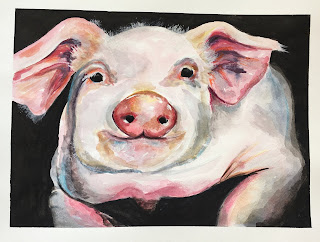 |
| Teacher Sample |
What better way to explore a medium than with a limited palette. It forces you to push the limits of color mixing, and to stay focused on subtle changes in value. My adults were exploring watercolor, and I thought a pig project was a great way to explore one color (well, one main color) and to analyze all the different shifts in value and intensity.
Pigs are a great animal to draw, because they are hairless, and their features are pretty straight forward (no foreshortened snouts). It's hard to go wrong.
Our color was red, and we included blue for shadows, yellow ochre for warmer tones and burnt umber for neutralizing shades. White was used for tints (pink and light blues) in tiny quantities for wisps of hair, and black to darken the deepest values in eyes and nostrils.
Students had many photos, illustrations and paintings of pigs to choose from. We drew our pig by observations, breaking down its features into basic shapes to determine their proper location, before refining and adding all detail.
As always with watercolor, we determined first our lighter areas and blocked these in with a super transparent wash of a barely there color (in the case of our pigs, a super light pinkish beige, most likely a mix of pink and ochre). Students had a scratch paper to explore color mixing, but we were not concerned with exact color matching, rather, we were more concerned with matching the values and intensity.
We continued building our layers, finding the next darker value and blocking it in, until we had our pig pretty much covered. Any hard edges were blended out with a wet brush, to create a soft transition between values. Sometimes it feels scary to keep going darker, for fear of 'messing' up your art, and some students had to be encouraged to take the plunge. When they did, their pigs showed much more dimension and form, and they quickly saw the benefits of a patient and steady build up of layers.
Small brushes were use for eyes, and we made sure to leave the reflection spot in the eyes white. A fine brush was used for wispy hairs. Backgrounds were done wet-on-wet in a faint blueish or grayish tone.
We had taped down our borders before painting. Revealing the white border once complete, gave our pig paintings a crisp, finished look.












